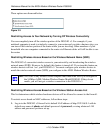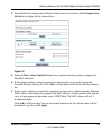
Reference Manual for the ADSL Modem Wireless Router DG834G
Wireless Configuration 3-11
v1.0, October 2006
Restricting wireless access prevents intruders from connecting to your network. However, the
wireless data transmissions are still vulnerable to snooping. Using the WEP data encryption
settings described below will prevent a determined intruder from eavesdropping on your wireless
data communications. Also, if you are using the Internet for such activities as purchases or
banking, those Internet sites use another level of highly secure encryption called SSL. You can tell
if a web site is using SSL because the web address begins with HTTPS rather than HTTP.
Authentication Type Selection
The DG834G v3 lets you select the following wireless authentication schemes.
• Automatic
• Open System
• Shared key
Set your wireless adapter according to the authentication scheme you choose for the ADSL
Modem Wireless Router. Please refer to
“Wireless Communications” in Appendix C for a full
explanation of each of these options, as defined by the IEEE 802.11g wireless communication
standard.
Encryption Choices
Please refer to
“Wireless Communications” in Appendix C for a full explanation of each of the
following choices, as defined by the IEEE 802.11g wireless communication standard. Choose the
encryption strength from the drop-down list:
Disable. No encryption will be applied. This setting is useful for troubleshooting your wireless
connection, but leaves your wireless data fully exposed.
64 or 128 bit WEP. When 64 Bit WEP or 128 Bit WEP is selected, WEP encryption will be
applied.
If WEP is enabled, you can manually or automatically program the four data encryption keys.
These values must be identical on all computers and access points in your network.
Note: The authentication scheme is separate from the data encryption. You can choose an
authentication scheme which requires a shared key but still leave the data
transmissions unencrypted. If you require strong security, use both the Shared Key
and WEP encryption settings.


















